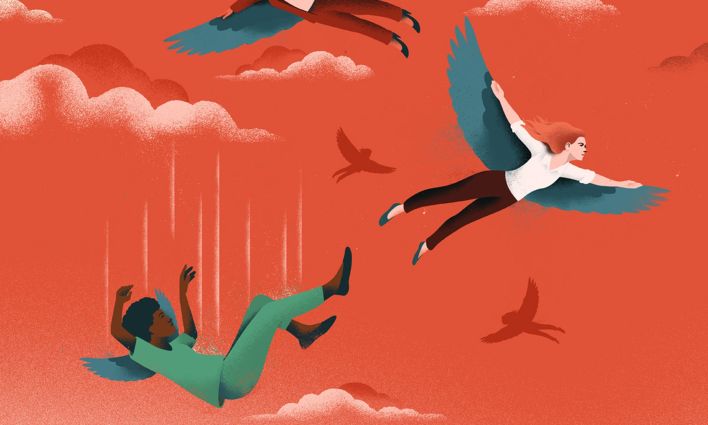When people ask me what I do, I say, “I teach high school…to adults.” If I just say I teach adults, most people assume I’m referring to post-secondary education; if I just say I teach high school, that erases the different population of learners I serve.
Adult & continuing education (A&CE) is often overlooked in our discussions of public education, and that has never felt truer than in the past year and a half. When schools in Ontario closed in March 2020 and then shifted classes to synchronous virtual learning, the experience of public education for most teachers, students, and parents changed dramatically.
But for me as an A&CE teacher, it felt like nothing had changed.
Let me describe an average teaching day for me pre-pandemic. My first class begins at 9:15 AM. Students gradually filter in, many arriving late due to vagaries of bus schedules, child care issues, and various appointments. I start my lesson on time for those who arrive punctually, and I try to catch up those who come in late. Over the next 2.75 hours, we work through a high school English or math lesson. After a half-hour lunch I do it all over again until 3:15 PM. Sometimes, I would teach simultaneously to students in the classroom and to students either at home or in another classroom at a remote site—what we are now calling hybrid learning. Of the 28.25 hours for which I am paid per week, 45 minutes of that is dedicated towards unscheduled preparation time.
That’s right: we A&CE teachers were already operating in ways similar to what many primary and secondary teachers across Ontario were required to shoulder through the pandemic.
Quadmesters of eight week courses, two classes a day. Hybrid learning comprising students both in-class and virtually at the same time. Little-to-no prep time. None of these are new to me. So when I heard we would be teaching either entirely virtually or in a hybrid mode for the 2020–21 school year, I didn’t blink. Other than the extra health and safety protocols, nothing had really changed for me as an A&CE teacher.
But everything had changed for my adult learners.
My learners come from diverse backgrounds. They range in age from 18 to their late 60s. Most have families. A high proportion are Indigenous. Others are newcomers to the country, sometimes refugees from situations far more traumatic than I could imagine. They bring decades of experience into my classroom.
Like their backgrounds, their goals are diverse too. Most need an Ontario Secondary School Diploma to change careers or begin one. Others seek a specific course for college or university admission. I’ve even had a few students who are simply there to graduate so that they can say they have. Whatever their origins and their plans, we accept these learners into our classrooms and work with them to help them succeed.
The shape of Ontario public education during this pandemic has not been random, and it did not have to be haphazard. What has changed—and what hasn’t—has been a deliberate policy decision, not an inevitable outcome of exigent circumstances.
When the Ontario Ministry of Education reacted to the pandemic by closing schools and shifting to virtual classes, my adult learners found themselves in a very difficult position. Parents had to supervise their kids, now learning at home alongside them—and that’s assuming their household had access to enough technology and Internet bandwidth for both parent and children to attend school at the same time. Many of my students also had to balance attending virtual school with being frontline workers. Finally, as any teacher and many students and parents will attest, interactions on a screen are just not the same as learning in person. Technical difficulties, privacy considerations, and the stress of the pandemic all made it so much harder for me to give my students the one-on-one support they deserved.
Despite all this, some of my learners appreciate these different learning models. For them, an attendance requirement is an insurmountable barrier even though they could otherwise succeed in my course. The most important skill I have developed in my years as an A&CE teacher has been flexibility. My adult learners need it, and younger learners need it too.
Yet this flexibility has not generally been forthcoming. One example would be the Ministry of Education’s mandate for a daily minimum of synchronous learning time. Educators and students at every level struggled with this expectation and the resulting screen time. My days were measured by the burnout I felt the moment I could switch off my camera at 3:30 PM. I felt like I wasn’t possibly doing enough for my students. In reality, I was doing my best with the resources and directives we had been provided. All of us could have benefited from the Ministry acknowledging that virtual school is more than just a different method of delivery.
The shape of Ontario public education during this pandemic has not been random, and it did not have to be haphazard. What has changed— and what hasn’t—has been a deliberate policy decision, not an inevitable outcome of exigent circumstances.
We must keep this in mind as we look to the future of our education system. If we create policy with flexibility and equity in mind, we can change all levels of education for the better. For my particular area, this means according A&CE teachers the same level of recognition—in our working conditions and our pay—as other teachers in Ontario. It also means considering how we can be flexible in our funding and attendance models to serve the needs of our adult learners. Finally, it means more explicit and frequent acknowledgement of the important role adult and continuing education serves in our society—and funding to support that message.
More broadly, our conversations around change in education must be nuanced and acknowledge that education cannot be one size-fits-all. If we create policy around the idealized student with fibre broadband, the latest tech, and no distractions at home, we will miss the mark on what education should be: a tool for removing barriers rather than reinforcing them.
Read the Winter/Spring 2022 edition of Our School/Our Selves here.







